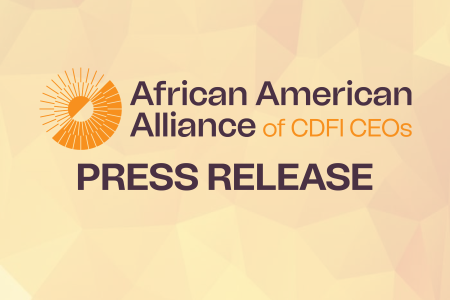The Alliance strongly urges the Fund to reserve the designation for only those CDFIs that can clearly demonstrate accountability to minority populations through the number of financial products and services it directs to those populations and through its board governance and/or and staff composition. Our comments below offer specific recommendations that will help the Fund identify those CDFIs with the highest levels of service delivery and accountability to minority populations.
—————————————————————————————————
November 21, 2022
Mr. Jeff Merkowitz
Senior Advisor
Community Development Financial Institutions Fund
U.S. Department of the Treasury
1500 Pennsylvania Avenue NW
Washington, DC 20220
Re: CDFI-2022-0001: Minority Lending Institution Designation Criteria.
The African American Alliance of CDFI CEOs (the Alliance) is pleased to provide the following comments in response to the CDFI Fund’s (the Fund) request for information regarding the criteria to designate a certified Community Development Financial Institution (CDFI) a Minority Lending Institution (MLI). The Alliance is a membership-driven intermediary organization that aims to: build the capacity of member organizations; build bridges to economic stability, well-being, and wealth for Black individuals, families, and communities; and build power in Black communities by challenging and influencing financial sectors to operate more equitably. Since launching in 2018, the Alliance has established a network of 69 CEOs of Black-led Community Development Financial Institutions (CDFIs), which includes loan funds, credit unions, and venture capital funds. Alliance members reach historically underserved communities in all 50 states by providing financial services in the small business, affordable housing, and commercial real estate development sectors.
CDFIs face many barriers as they strive to increase access to capital across minority populations. The Alliance appreciates the Fund’s effort, through the MLI designation, to recognize the diligence of CDFIs as they continue to improve the social and economic outcomes for minority communities that have historically been excluded from the traditional financial services system. However, the Alliance strongly urges the Fund to reserve the designation for only those CDFIs that can clearly demonstrate accountability to minority populations through the number of financial products and services it directs to those populations and through its board governance and/or and staff composition. Our comments below offer specific recommendations that will help the Fund identify those CDFIs with the highest levels of service delivery and accountability to minority populations.
Definitions—Minority and Majority-Minority Census Tracts
1. Are the proposed definitions of “Minority” and “Majority-Minority Census Tracts” appropriate for the purposes of designating an MLI?
The Consolidated Appropriations Act of 2021 (the Act) defines an MLI as a CDFI that (i) directs a majority of its financial products to minority populations or communities; and (ii) either (a) is a Minority Depository Institution (MDI) or (b) demonstrates accountability to Minority
populations. The Act defines “minority” as “any Black American, Hispanic American, Asian American, Native American, Native Alaskan, Native Hawaiian, or Pacific Islander.” The Fund proposes to define “Majority-Minority Census Tracts,” for purposes of designating an MLI, as “those census tracts or equivalents in which the sum of the tract’s non-duplicative population of Minority persons is greater than 50 percent of the census tract’s total population, as determined by the U.S. Census Bureau.”
The proposed definitions of “Minority” and “Majority-Minority Census Tracts” ensure that MLI designation will be reserved for those CDFIs with a track record of increasing access to capital for minority populations that have historically been underserved by the traditional financial services system. For this reason, the Alliance believes the proposed definitions of “minority” and “majority-minority census tract” are appropriate for purposes of designating a CDFI as an MLI.
Designation Criteria—Financial Products Directed to Minorities and Majority-Minority Census Tracts
2. Is a rolling 36-month period the appropriate length of time to assess an applicant’s track record of serving Minorities or Majority-Minority Census Tracts for the purposes of designating a CDFI an MLI? Should the Fund instead require applicants to meet this requirement using some other time period, either upon initial designation or to maintain the designation? If yes, what is an appropriate time period?
For purposes of meeting MLI designation criteria, the Fund proposes that an applicant must demonstrate that it has directed greater than 50 percent of both the number and dollar volume of its arm’s length, on-balance sheet Financial Products to minorities or majority-minority census tracts over the most recently completed 36 months upon initial designation, and on a three-year rolling average over each subsequent completed fiscal year to maintain the MLI designation.
The Alliance believes that using a rolling multi-year average to assess the extent to which a prospective or existing MLI has met the Financial Products test is warranted. Such a provision is responsive to unforeseen events that lead to significant one-time fluctuations in demand for a CDFI’s Financial Products, which could ultimately disqualify otherwise strong MLI candidates absent a multi-year track record provision. Furthermore, a multi-year track record provision accounts for unique circumstances surrounding an CDFI’s lending activities (e.g., making loans of different sizes and differing quantities) that may result in its failure to meet either the “number of units” or “dollar value” thresholds in a given year. Said activities may not reflect a failure on the part of the CDFI to direct its Financial Products to minorities or majority-minority census tracts but would ultimately disqualify it from MLI consideration without the flexibility afforded with a multi-year track record provision.
However, the Alliance recommends that a three-year track record of serving minority populations is not sufficiently long enough to adequately reflect a CDFI’s intentional commitment to providing financial products and services to minority populations. Instead, we recommend that the CDFI Fund require applicants demonstrate its commitment to service of
minorities and/or minority majority populations through a rolling 60-month track record of direct financing experience to minorities and/or majority-minority census tracts. Further, the Alliance recommends that an applicant demonstrate that it has directed at least 60 percent, not 50 percent, of its direct financing dollars to minorities or majority-minority census tracts over the most recent 60-month period as a condition of being designated an MLI. We believe these recommendations, if implemented, will ensure that the MLI designation is reserved for only those CDFIs that have a strong commitment to and have effected positive change in minority communities.
3. The Act requires that an MLI must direct a majority of its financial products “at minorities or majority-minority census tracts or equivalents.” Should the Fund assess Financial Products delivered to legal entities that are not owned or controlled by Minority individuals to finance projects such as affordable housing, childcare centers, charter schools, or health centers that are not located within a Majority-Minority Census Tract but whose end-beneficiaries (e.g., customers, residents, or employees) are members of a Minority population? If yes, how?
Many CDFIs, including Alliance members, can meaningfully impact and improve the economic circumstances of minority populations even if they do not directly lend to such populations. For instance, CDFIs often finance entities that are neither owned by minority individuals nor located in majority-minority census tracts, but whose projects that improve the health, safety, welfare, and education of minority populations. For this reason, the Alliance generally supports a policy that would allow a CDFI to satisfy the MLI Financial Products test through its lending activities to finance certain projects (e.g., affordable housing projects, childcare centers, charter schools, or health centers) that are neither owned by minority individuals nor located in majority-minority census tracts but whose end-users are members of a minority population. However, the Alliance recommends that a CDFI seeking MLI designation on these grounds demonstrate that at least 25 percent of the facility’s and/or project’s ultimate beneficiaries (e.g., housing tenants, childcare center students, charter school students, clinic patients) are members of a minority population. Alternatively, the Alliance recommends that an applicant demonstrate that the percentage of the facility’s and/or project’s ultimate beneficiaries that are members of a minority population be at least proportional to the percentage of residents in the CDFI’s target market that meet the definition of minority.
Designation Criteria—Accountability
4. Should a majority (greater than 50 percent) of a CDFI’s governing board members be required to be members of Minority populations to demonstrate accountability to Minority populations? Specifically, the CDFI Fund requests comments on whether it should set a standard higher than the 33 percent level proposed separately for Native CDFI designation and for general Target Market accountability as part of the CDFI Fund certification standards.
The Alliance believes that at least 51 percent of a CDFI’s governing board representatives should be members of a minority population in order to demonstrate accountability to minority populations for purposes of satisfying MLI designation criteria. While we are cognizant of the concern that minimum thresholds for board member representation may inhibit a CDFI’s ability to identify and retain qualified board members, we do not view a “50 percent plus one” requirement as a significant limiting factor for CDFIs in their recruitment of talented and diverse individuals that share their strategic and operational vision. Furthermore, the Alliance believes the benefits of a governing board that is representative of the minority population it serves far outweigh any risk that the performance of the governing board is adversely impacted by such a requirement.
5. Should there be options for CDFIs to meet the accountability requirement through a lower threshold of Minority representation on a CDFI’s governing board? If yes, what level of representation is appropriate?
As stated, the Alliance strongly prefers that a majority of CDFI governing board members be members of minority populations in order to satisfy the MLI accountability requirement. However, we would support an exception to the “50 percent plus one” board governance rule if other standards for demonstrating accountability to minority populations are met. For instance, CDFIs should be allowed to meet the MLI accountability requirement with less than 51 percent of minority representation on its board if: (i) it has at least 33 percent minority representation on its governance board; and (ii) it has at least 51 percent minority representation on its loan committee; and (iii) at least 33 percent of its senior executive leadership individuals that identify as minorities; (iv) at least 51 percent of its day-to-day management personnel (e.g., directors) are individuals that identify as minorities; and (v) it has as its CEO someone who identifies as a minority. The applicant seeking MLI designation through the alternate means described above should have a track record of at least three years of direct financing experience and has dedicated at least 60 percent of its direct financing dollars to minorities or minority majority census tracts or equivalents over the past 60 months. While providing flexibility around CDFI governance board composition, this recommendation also ensures that CDFIs have demonstrated a commitment to serving minority populations through several stringent mechanisms.
6. Given the regulatory requirements for the governing board composition of regulated financial institutions, as well as the absence of governing boards for some privately held companies, should there also be an option for non-MDI regulated entities or privately held entities without a governing board to demonstrate accountability for the purposes of MLI designation? If yes, what standard should be used?
While we understand the unique and important role non-MDI regulated entities and privately held entities without a governing board play in supporting community development, the Alliance would not support any option that would allow such entities to demonstrate accountability to minority populations for purposes of MLI designation through any other means than those afforded CDFIs and MDIs. As stated, we believe that reserving MLI designation for entities with
governing boards that are predominately representative of the communities for which they serve is critical to ensuring that minority populations are properly served by those entities.
7. Should the CDFI Fund allow the ownership of a CDFI to demonstrate accountability to Minority populations, either as an alternative to accountability through a governing board or in combination with a lower threshold of representative governing board members? If yes, should accountability mirror the MDI definition (i.e., 51 percent or more of the voting stock is owned by minority individuals) to be counted in determining minority ownership? If ownership should be permitted to demonstrate accountability only in combination with some level of governing board representation, what should that threshold be?
The Alliance believes that the Fund should allow the ownership of a CDFI to demonstrate accountability to Minority populations. In such cases, no less than 51 percent of its equity ownership interest must be owned by one or more individuals that identify as minorities. In the case of a partnership, at least 51 percent of every class of partnership interest must be unconditionally owned by one or more individuals that identify as minorities. In the case of a corporation, at least 51 percent of each class of voting stock outstanding must be unconditionally owned by one or more individuals that identify as minorities. In the case of an LLC, at least 51 percent of each class of member interest must be unconditionally owned by one or more individuals that identify as minorities. In the case of a publicly owned entity, no less than 51 percent of its stock must be owned by one or more individuals that identify as minorities.
Additionally, for each of the entities described above, (i) the CEO must identify as a minority; and (ii) no less than 33 percent of its senior executive leadership personnel combined (e.g., balance of C-suite and VP-level) are comprised of one or more individuals that identify as a minority; and (iii) at least 51 percent of its day-to-day management (e.g., directors) personnel is comprised of one or more individuals that identify as minorities. Finally, the applicant seeking MLI designation through the alternate means described above should have a track record of at least three years of direct financing experience and has dedicated at least 60 percent of its direct financing dollars to minorities or minority majority census tracts or equivalents over the past 60 months.
8. If a CDFI serves multiple Minority populations, for purposes of the MLI designation should it be required to have board or other representation reflective of each of the Minority populations it serves? If yes, how should the share of board or other representation for each Minority population the CDFI serves be determined?
The Alliance believes that CDFIs serving multiple minority populations should have board governance compositions that are reflective of each of the minority populations served. To the extent practicable, the minority membership of the CDFI governing board should approximate the percentage of the CDFI’s borrowers that belong to a minority population. In other words, if 70 percent of a CDFI’s minority customers identify as Black and 30 percent identify as Hispanic, then the CDFI should strive for a similar ratio for its minority governance board membership.
However, the Alliance understands that, for any number of reasons, an applicant may not have board representation reflective of each of the minority populations it serves at the time of its MLI application. In such cases, an applicant should not be disqualified from receiving an MLI designation to the extent it can demonstrate that it has made a good faith effort to have a governing board that is reflective of the minority populations it serves.
The Fund is also considering the relationship between the standards for designation as an MLI and those for designation as a Native CDFI. To what extent should the two align?
The Alliance will defer to our Native CDFI partners for recommendations.
In closing, the MLI designation is illustrative of the Fund’s recognition of the critical role CDFIs play in narrowing the racial wealth gap across the nation. Alliance members are on the front lines of that fight and will continue to provide critical services to minority populations that have been overlooked by the traditional financial services system. We welcome continued discussions with the Fund and our members look forward to applying for MLI designation. Please contact Lenwood V. Long, Sr., President and CEO, at [email protected] for any clarifying questions or comments.
Sincerely,
Lenwood V. Long Sr. President & CEO, African American Alliance of CDFI CEOs




